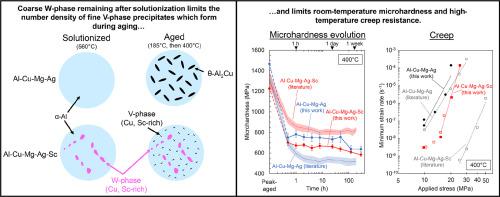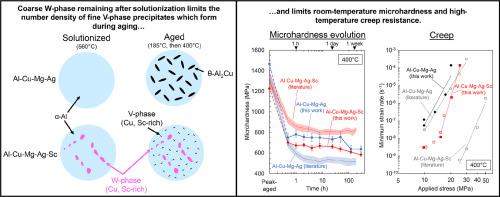Effect of Sc additions on precipitation behavior and creep- and coarsening resistance of a cast Al-4.5Cu-0.3Mg-0.4Ag (wt%) alloy
IF 9.3
1区 材料科学
Q1 MATERIALS SCIENCE, MULTIDISCIPLINARY
引用次数: 0
Abstract
The effects of solidification rates and solutionizing temperatures on V-phase (Al8Cu4Sc) nanoprecipitate formation and subsequent mechanical properties in a cast Al-4.5Cu-0.3Mg-0.4Ag-0.3Sc (wt%) alloy are evaluated. After solutionizing, Ω-Al2Cu precipitates are formed upon aging at 185 °C and then transformed into Al8Cu4Sc V-phase precipitates at 400 °C, showing high coarsening resistance. Avoiding Al8-xCu4+xSc W-phase precipitation during solidification is crucial, as this phase reduces the concentration of Cu and Sc available in the matrix for Al2Cu Ω-precipitation at 185 °C and the subsequent final formation of V-precipitates at 400 °C, affecting microhardness at ambient temperature and creep strength at 400 °C. Solutionizing temperatures between 580 and 600 °C dissolve the undesirable W-phase but form large stable θ-Al2Cu phases, which also scavenge Cu. Furthermore, the W-phase was observed both under relatively fast solidification in a graphite mold and very slow solidification in a furnace, and the microhardness was similar under the two casting conditions. Similarly, adding 0.15Si wt% does not impact the mechanical properties of the alloy. These findings suggest that Al-Cu alloys with V-phase precipitates have promising potential for high-temperature applications, although further study of the processing techniques is necessary to fully utilize their capabilities.


Sc添加量对Al-4.5Cu-0.3Mg-0.4Ag (wt%)铸造合金析出行为及抗蠕变和抗粗化性能的影响
研究了凝固速率和固溶温度对铸造Al-4.5Cu-0.3Mg-0.4Ag-0.3Sc (wt%)合金中v相(Al8Cu4Sc)纳米沉淀形成及其力学性能的影响。固溶后,185℃时效形成Ω-Al2Cu相,400℃时效形成Al8Cu4Sc v相,具有较高的抗粗化性能。在凝固过程中避免Al8-xCu4+xSc w相的析出是至关重要的,因为这一相降低了Al2Cu Ω-precipitation在185℃时基体中Cu和Sc的浓度,随后在400℃时最终形成v相析出,影响了室温下的显微硬度和400℃时的蠕变强度。在580 ~ 600℃的溶解温度下,不需要的w相被溶解,但形成稳定的θ-Al2Cu相,也能清除Cu。此外,在石墨模中相对快速凝固和在炉中非常缓慢凝固条件下均观察到w相,并且两种铸造条件下的显微硬度相似。同样,添加0.15Si wt%也不会影响合金的机械性能。这些发现表明,具有v相沉淀的Al-Cu合金具有很好的高温应用潜力,但需要进一步研究加工技术以充分利用其能力。
本文章由计算机程序翻译,如有差异,请以英文原文为准。
求助全文
约1分钟内获得全文
求助全文
来源期刊

Acta Materialia
工程技术-材料科学:综合
CiteScore
16.10
自引率
8.50%
发文量
801
审稿时长
53 days
期刊介绍:
Acta Materialia serves as a platform for publishing full-length, original papers and commissioned overviews that contribute to a profound understanding of the correlation between the processing, structure, and properties of inorganic materials. The journal seeks papers with high impact potential or those that significantly propel the field forward. The scope includes the atomic and molecular arrangements, chemical and electronic structures, and microstructure of materials, focusing on their mechanical or functional behavior across all length scales, including nanostructures.
 求助内容:
求助内容: 应助结果提醒方式:
应助结果提醒方式:


